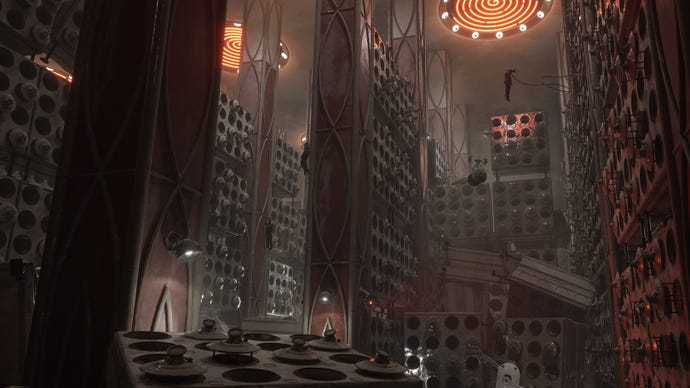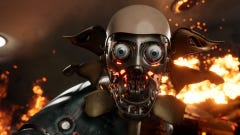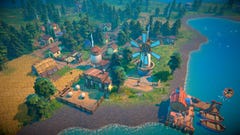Atomic Heart releasing late this year, and devs promise it won't be a Half-Life or Bioshock clone
Watch the new trailer and read our dev Q&A
Freaky sci-fi shooter Atomic Heart has often been as mysterious as the Soviet research base-cum-house of robot horrors it takes place in. It looks like the four-year wait for answers will end this year, though: a new story trailer ends with confirmation of a 2022 launch, apparently in a month ending in “ber”. As in, “#######ber” literally pops up on screen. There’s your release window, puzzle fans.
This does at least narrow Atomic Heart’s release date to the final four months of the year. And in the meantime, there’s plenty of weirdness to pick apart in the trailer: moustachioed androids, giant drill worms, a flying city, and that pyromaniac nan from the E3 2022 trailer. Not to mention some fresh looks at Atomic Heart’s combat, which blends axes and AK-47s with the the superpowers of "the Glove". Here it be, and there’s also an original Russian version if you’d prefer less questionable lip syncing.
Despite the Glove's proximity to BioShock's Plasmids, word from developers Mundfish is that this won't be a retread of immersive sims past. We posted some questions to the dev team at large, digging up more info on Atomic Heart’s trailblazer aspirations, the source of all that perverted Russian science, and the challenges and importance of the game’s ambitious visual design.
RPS: You've spoken about how you want to create a game that stands alongside titles such as Bioshock, Fallout and Doom. What is it about those games that has stood the test of time for you, and how does Atomic Heart build on those ideas, lessons and philosophies?
Mundfish: First and foremost, these are truly exceptional, generation-defining games. The games that make you take a vacation to fully immerse yourself in their worlds. There are not so many titles like that nowadays. And we always wanted to create something like that. We wanted to create a game that will captivate and immerse you. And we think that an endeavour like that can’t be boiled down to some rules of thumb and data-driven development decisions like ‘put this, this, and this so you create a masterpiece of a game’. It’s pure creativity. And frankly speaking, no one wants a Half-Life or BioShock clone. Original games rule. And when we started working on Atomic Heart, that’s the way we went – the difficult way of creating new things, listening to our guts, steadily throwing aside mechanics and ideas we didn’t like, and elevating stuff we fell in love with.
The team also wanted to reinvent as many aspects of game design as possible – the looting, enemy spawns, things like that. We tried to think two steps ahead with every system, think about how they can be evolved. And none of that could be possible without the team effort – we are a group of really passionate people who pour our hearts and souls into this game.

The weapons we've seen so far look very creative and interesting. Since this is set in an alternate universe to modern day, tell us more about how technology has evolved in this world. Does anything have a historical, real-world equivalent that it's evolved from? What were your touchstones when it came to building the world as a whole?
The thing that influenced Atomic Heart's world the most is the Polymer — an omnipotent substance invented by Professor Sechenov. Polymer can be used in various fields of science, and it was the catalyst that propelled the USSR to new heights across robotics, AI, weaponry development, biology, physics, etc. This is something far more potent than nuclear energy, but the risks are also present. And that's what you'll learn in the game.
Ray traced lighting, shadows and reflections in games weren’t even available to players until a few months after Atomic Heart was revealed, and when the first real-time ray tracing demo launched, these were seen as this big new innovations. Now that the tech has been around for a while, have you stuck closely to the aesthetics of that initial tech demo, or have you been looking for ways to push it further?
We've been looking for ways to improve our picture quality and details ever since the development had started. These technologies are very important for delivering the visual identity of the game that we've created.
How important is this near photorealism to Atomic Heart as a whole? It looks like a big part of the fantastical and horror elements come from juxtaposing them against very lifelike people and places.
We want the game to look extremely realistic and yet weird, even uncanny at times. This is where cutting-edge tech meets the unique art design, world, characters, weapons. Our goal is to create an extremely immersive experience for the players, so they remember this universe for years to come.

Something else the game pre-dates is the current GPU shortage. Has this affected development at all? Either in a logistical way, like problems getting hold of the latest graphics cards for testing, or in a design sense, like the need to cater for players who might be stuck on older PC hardware for longer?
The team is hard at work to optimise the game so it works well on as many types of hardware as possible. And yes, the pandemic has had its own implications on the development and logistics, but we managed to adapt to the situation rather quickly.
Speaking of catering for lower-end hardware, we’ve heard how effects like ray tracing are built into the character design, like with the Belyash and spinning spotlight effect coming out of its head. Has there ever been a worry that running the game on lower settings might diminish more than just simple fidelity?
Of course, the optimization process comes with some compromises, but we'll make sure that the creative vision is delivered no matter how or where you play Atomic Heart.
DLSS in particular has evolved a lot over the past few years, especially with the jump to DLSS 2.0 in 2020. Has keeping up with these changes presented challenges, or opportunities?
We would say both, but we work in close collaboration with Nvidia, so it helps us to get incredible results.

AMD has its own upscaling tech in FidelityFX Super Resolution, and Intel will eventually launch XeSS with its Arc GPUs. Are there any plans to support either of these, as a DLSS alternative for those without RTX graphics cards?
We're always open to new technologies and interested in delivering the maximum possible quality of the game for all gamers despite the platform. But every technology requires time for implementation and testing for such big games. So it's hard to say at the moment which exact technology will be available at release. All supported technologies will be announced closer to release.
In a previous interview from 2020, the team said they were interested in trying some other, unspecified RTX and DirectX 12 features that were new at the time. Are any of these features making it into the game as it stands?
We’re planning to cover the technical aspects of the game a bit later and go over all the technologies we’ll be using.
When developing with Nvidia-exclusive features, how involved are Nvidia themselves? How much of a collaborative effort is it to implement things like ray tracing and DLSS?
NVIDIA has been an amazing partner both in development and marketing, and we look forward to growing this relationship even further.


















